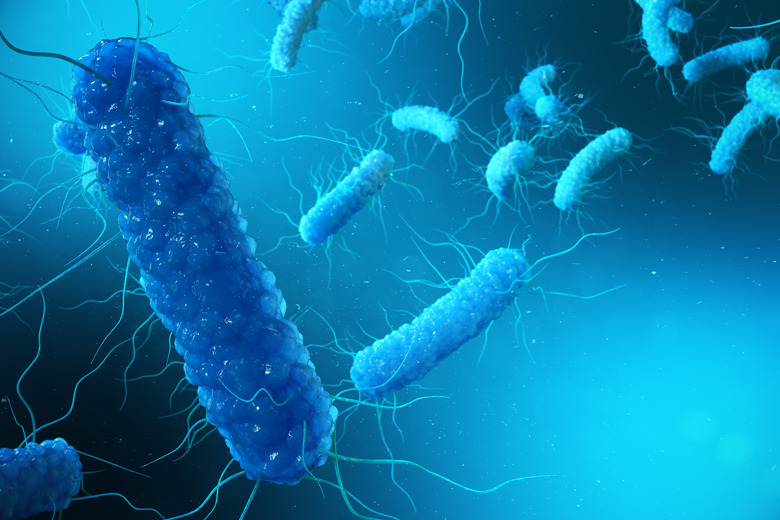How Cell Organelles Work Together
The cells that make up all organisms are highly organized structures, specifically designed to carry out processes necessary for life. The simplest cells belong to prokaryotes such as bacteria. The cells of eukaryotes, which are animals, plants, fungi and protists, are more complex. Within each eukaryotic cell, specialized structures called organelles work together to perform all life functions. One of the most important functions in the cell is making and processing proteins. Several organelles are directly involved in protein synthesis, while others provide support by performing ancillary duties necessary to keep the cell functioning properly for protein synthesis to occur.
Nucleus
Nucleus
The nucleus is the control center of the cell where DNA is housed. The DNA contains all the cell's genetic information as well as the information the cell needs to carry out its functions, including reproduction. Here, DNA makes RNA by transcription, which begins the process of protein synthesis. The nucleolus is a small organelle within the nucleus where ribosomes are manufactured. In plant cells, chloroplasts necessary for photosynthesis are found in the nucleus.
Endoplasmic Reticulum
Endoplasmic Reticulum
The structure of the endoplasmic reticulum is similar to a folded membrane. There are two types: rough and smooth. Smooth endoplasmic reticulum is where lipid synthesis occurs, and where the organelle handles toxic substances within the cell. Rough endoplasmic reticulum is named for its rough appearance due to ribosomes attached to its folds. This is where most protein synthesis occurs.
Ribosomes
Ribosomes
Ribosomes are usually attached to the rough endoplasmic reticulum but may also float freely in the cytoplasm. They are the main site of protein synthesis.
Golgi Apparatus
Golgi Apparatus
The Golgi apparatus functions like a post office. Proteins are packaged and sent to the Golgi apparatus for distribution. Vesicles are formed and then delivered to the site on the cell membrane where they release protein molecules during exocytosis or envelop external substances and incorporate them into the cell during endocytosis. Some of the protein-carrying vesicles remain in the Golgi apparatus for storage. The Golgi complex is also responsible for making lysosomes.
Vesicles
Vesicles
Vesicles are small sacs that contain substances and transport them around the cell. They also carry substances in and out of the cell. Vesicles transport substances from the site of synthesis to the cell membrane for export and from the cell wall to other organelles with imported substances.
Plasma Membrane
Plasma Membrane
The plasma membrane is a two-layer barrier that separates the cell from its environment and allows certain substances to be imported or exported. Proteins in the membrane control the passage of molecules in and out of the cell.
Mitochondria
Mitochondria
Responsible for the cell's metabolism, the mitochondria is the power plant of the cell that converts energy from food into ATP to be used for cell functions.
Cytoskeleton
Cytoskeleton
The cytoskeleton is the framework of the cell. It consists of microtubules and microfilaments that give structure to the cell and allow for the movement of vesicles and other components around the cell.
Cytoplasm
Cytoplasm
The cytoplasm is a water-based substrate makes up the interior of the cell and surrounds the organelles. It fills the spaces between organelles and helps the cytoskeleton move protein-carrying vesicles around the cell from the endoplasmic reticulum to the Golgi complex and the plasma membrane.
Lysosomes
Lysosomes
The root lyse means to loosen or unfasten. The job of lysosomes is to break down worn-out or damaged cell components, digest foreign particles, and defend the cell against bacteria and viruses that breach the cell membrane. Lysosomes use enzymes to perform these functions.
Protein Power
Protein Power
Much of a cell's efforts go toward making proteins. Proteins carry out many important functions in the body. There are two types of proteins: structural proteins and enzymes. Structural proteins are used to form the framework of tissues such as bone, skin, hair and blood such as collagen, and enzymes that are used to regulate cellular functions by facilitating chemical reactions such as digestion. Cell organelles must work together to carry out protein synthesis, utilize proteins within the cell, and transport them out of the cell.
Protein Synthesis
Protein Synthesis
To make proteins, DNA transcribes information into RNA in the nucleus. Transcription is like making copies of the information from DNA and applying this information in a new format. The RNA exits the nucleus and travels through the cytoplasm to ribosomes on the rough endoplasmic reticulum. Here, the RNA goes through translation. Like translating from one language to another, the information the DNA copied onto the RNA during transcription is translated into a sequence of amino acids. The amino acid chains, or polypeptides, are assembled in the correct sequence to form proteins.
Packaging and Transport
Packaging and Transport
After proteins are synthesized, a portion of the rough endoplasmic reticulum pinches off and separates to form a protein-filled vesicle. The vesicle travels to the Golgi complex where the protein is modified if necessary and repackaged into a new vesicle. From there the vesicles carry the protein to another organelle where it will be used within the cell or to the plasma membrane for secretion. Vesicles may also store the protein within the cell for later use. The microfilaments and microtubules of the cytoskeleton move the vesicles where they need to go.
Cite This Article
MLA
Mentzer, A.P.. "How Cell Organelles Work Together" sciencing.com, https://www.sciencing.com/cell-organelles-work-together-5492286/. 24 April 2019.
APA
Mentzer, A.P.. (2019, April 24). How Cell Organelles Work Together. sciencing.com. Retrieved from https://www.sciencing.com/cell-organelles-work-together-5492286/
Chicago
Mentzer, A.P.. How Cell Organelles Work Together last modified March 24, 2022. https://www.sciencing.com/cell-organelles-work-together-5492286/
